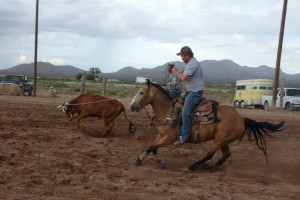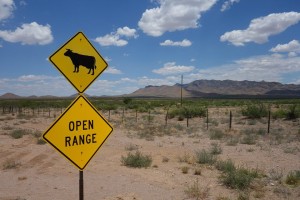“Neighboring”: a preliminary look at generosity and mutual aid among ranchers in the American Southwest
By Lee Cronk
The Human Generosity Project
July 17, 2015
Many people dream about being a cowboy, but what is it really like? Here’s how one retired rancher described it: “There are a lot of opportunities to injure yourself.” Another put it even more succinctly: “It is a very dangerous business.” Nevertheless, those who are drawn to ranching and especially those who stick with it all have one thing in common: They absolutely love it, despite the risks and hardships it often entails.
I recently returned from a month of fieldwork among ranchers in the region many refer to as the Malpai borderlands, located in Hidaldo County, New Mexico and Cochise County, Arizona, just north of the US-Mexico border. The region is dominated by three mountain ranges – the Chiricahuas, the Peloncillos, and the Animas Range – and four valleys – the San Simon, San Bernardino, Animas, and Playas. The area includes a variety of environments including grasslands, woodlands, and desert, with altitudes ranging from less than 4,000 to nearly 10,000 feet. I based myself in Rodeo, New Mexico, right on the border with Arizona.
Most ranches in the area are family operations. Although cattle prices at the moment are good, few families find that they can make a living solely from ranching. To make ends meet, people do a wide variety of things including horse breeding, commercial hunting, renting out land to quail and deer hunters, owning small businesses, and a wide variety of jobs in nearby towns and cities. Ranches vary in terms of the degree of control they have over the land on which they run livestock. A few have deeds to all the land they use, but more often a ranch is a combination of deeded land and land owned by the federal and state governments to which the rancher has limited access. Some ranches are on contiguous tracts of land, but many of them are broken up into multiple physically separated holdings.
My interviews focused on two main issues: The risks and hazards associated with ranching and the ways in which ranchers cooperate with each other. Nearly everyone to whom I spoke mentioned the weather as the biggest risk they face. They are particularly wary of droughts, but heavy rains can also cause a variety of problems including washed out roads and drowned cattle.
After the weather, interviewees brought up a variety of different problems including unpredictable market forces, government regulation, estate taxes, predators, and the scarcity of people who really know how to work with cattle.
Injuries were also frequently mentioned. Most occur while people are working with livestock and arise from the inherent unpredictability of cattle and horses. Others involve various pieces of heavy equipment that are often involved in modern ranching operations.
Because most ranches are family-run, few of them have enough skilled people on hand to deal with such large chores as branding and shipping cattle. Although some do hire cowboys to help with that sort of work, many complain about the difficulty of finding people who still have the skills necessary to do the work efficiently and safely. Having an unskilled person around, rather than being helpful, is actually a detriment, as in this saying I heard more than once: “A person that don’t know cattle is like two good cowboys gone.”
However, once source of skilled labor is readily available: One’s neighbors. And not only do the neighbors have the skills, they also have the same need. This creates a perfect situation for a regular, steady exchange of labor. Ranchers in the Malpai region refer to this as “trading work” or “neighboring,” as in this quote from one rancher: “I’ve been neighboring with the Millers since I don’t know when.” Neighbors, who may live as much as two hours’ drive apart from each other, negotiate with each other regarding the dates certain types of work will be done, and then they show up and help out. In such situations, there are two unstated expectations: first, that they will be fed, and, second, that they will receive similar help when they need it on their ranch. This pattern fits well within the framework of a balanced, tit-for-tat, account-keeping type of reciprocity.
But what happens when needs are not so predictable – say, when a rancher is injured or when a rancher’s equipment suddenly and unexpectedly fails? In those situations, all interviewees agreed that neighbors would come to that person’s aid with no questions asked and no expectation of any return apart from a similar generosity should they ever be in a similar bind. This kind of behavior is simply seen as being neighborly, and no accounts are kept. A few quotes from the interviews capture the spirit of this kind of neighborliness:
“If there’s any major occurrence that happens these little communities all come together take care of those left behind, clean their houses, feed them, really amazing.”
“I don’t think anybody keeps track. If you kept track it would become a headache . . . . If somebody needs help, you help them . . . . My family’s never worked that way and we never will . . . It all comes out in the wash.”
“It’s a solidarity-type world out here.”
Rather than balanced reciprocity, this type of generosity fits the pattern of risk-pooling through need-based transfers that Human Generosity Project team members are busy studying at their field sites, in their laboratories, and through their computer models.
The key variable seems to be the predictability of the need. When different individuals have needs at different times but those needs are predictable, it is easy for them to set up a system in which they exchange favors back and forth in a regular and balanced way. But when needs arise unpredictably, as in the case of injuries, it appears to be more adaptive to give to those in need because you may be the one in need on another day.
The next step for the Human Generosity Project at this site will be to design and administer a survey regarding patterns of risk, need, and generosity among the ranchers in Hidalgo and Cochise Counties. The data we gain from the survey will enable us to test our ideas about the role that the predictability of need plays in determining patterns of cooperation as well as a variety of other ideas.
Acknowledgements
We would like to thank the John Templeton Foundation for its support of this fieldwork and the following individuals for their time and generosity: Bob Boss, Peggy Boss, Ben Brown, Crystal Brown, Bill Cavaliere, Bill Cloudt, Nancy Cloudt, Billy Darnell, Ed Elbrock, Warner Glenn, Kelly Glenn-Kimbro, Sally Holcombe, G. Ray Johnson, Don Kimble, Frank Krentz, Bill McDonald, Vicky Merritt, Bill Miller, Ted Troller, and Rich Winkler.
SHARE THIS PAGE:



This kind of need-based mutual helpfulness is exactly what characterizes relationships among hunter-gatherer language groups when I studied them in the Kalahari. within each language group, as among the various camping parties (bands) there was a lot more reshuffling of personnel going on over time, of course, since this was a way of lowering dependency ratios locally. Work intensity and duration was thus more easily and manageably matched to need: camps with larger numbers of young dependent children added some older couples. Older hunters contributed to meat supplies, thus lowering the camp-wide dependency ratio for shared animal protein which was mostly derived from men’s work. Meanwhile older women contributed to the individual households of younger female relatives, lowering the dependency ratio for individual households.
Here in rural Alberta, where I live now, there is very similar mutual helpfulness among farm families. If my neighbour’s cattle get out of the fenced area unto the road, I automatically round them up and drive them back before anyone (or any animal) can get hurt on the road. People who are ill routinely have help from neighbours who take over the livestock tending. The development of larger commercial farms run by absentee corporate entities breaks up this kind of community, unfortunately.
Thanks, Helga, for the thoughtful comments! Your insights about the Kalahari remind me of the Hadza, which is also one of our sites, supervised by Colette Berbesque. And your experiences in Alberta match with my father’s as a child visiting his grandfather’s farm in Iowa and my own from a period around 25 years ago when my wife and I lived in rural Texas, where I also did a little impromptu catttle herding when our landlord’s small herd got loose. In short, need-based transfers seem to be ubiquitous, although the exact forms they take vary a great deal.